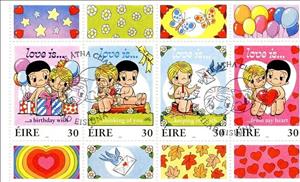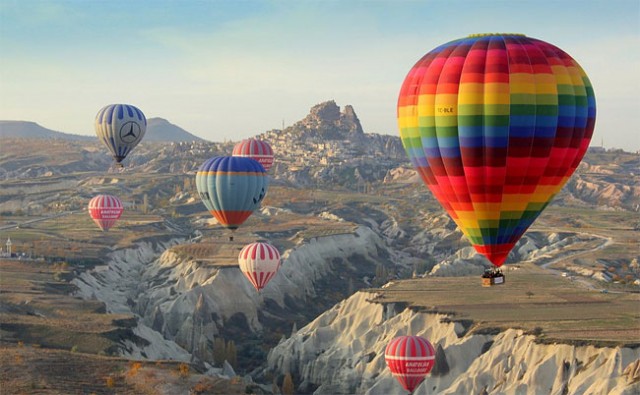Booklet Pane: Booklet pane 1 (Ireland 1998)
Booklet pane 1 (Ireland 1998)
06 May (Ireland ) within release Greetings Stamps 1998 (2nd series) goes into circulation Booklet Pane Booklet pane 1 face value 4*30 Irish penny
| Booklet Pane Booklet pane 1 in catalogues | |
|---|---|
| Michel: | Mi: IE HB81 |
Booklet Pane is square format.
Also in the issue Greetings Stamps 1998 (2nd series):
- Booklet Pane - Booklet pane face value 4*32;
- Booklet - Greetings/Love is face value 2.40;
- Booklet Pane - Booklet pane 1 face value 4*30;
Booklet Pane Booklet pane 1 it reflects the thematic directions:
A hot air balloon is a lighter-than-air aircraft consisting of a bag, called an envelope, which contains heated air. Suspended beneath is a gondola or wicker basket (in some long-distance or high-altitude balloons, a capsule), which carries passengers and a source of heat, in most cases an open flame caused by burning liquid propane. The heated air inside the envelope makes it buoyant, since it has a lower density than the colder air outside the envelope. As with all aircraft, hot air balloons cannot fly beyond the atmosphere. The envelope does not have to be sealed at the bottom, since the air inside the envelope is at about the same pressure as the surrounding air. In modern sport balloons the envelope is generally made from nylon fabric, and the inlet of the balloon (closest to the burner flame) is made from a fire-resistant material such as Nomex. Modern balloons have been made in many shapes, such as rocket ships and the shapes of various commercial products, though the traditional shape is used for most non-commercial and many commercial applications.
The hot air balloon is the first successful human-carrying flight technology. The first untethered manned hot air balloon flight in the world was performed in Paris, France, by Jean-François Pilâtre de Rozier and François Laurent d'Arlandes on November 21, 1783, in a balloon created by the Montgolfier brothers. The first hot air balloon flown in the Americas was launched from the Walnut Street Jail in Philadelphia on January 9, 1793, by the French aeronaut Jean Pierre Blanchard. Hot air balloons that can be propelled through the air rather than simply drifting with the wind are known as thermal airships.
The heart is a muscular organ found in most animals. This organ pumps blood through the blood vessels of the circulatory system.The pumped blood carries oxygen and nutrients to the body, while carrying metabolic waste such as carbon dioxide to the lungs.In humans, the heart is approximately the size of a closed fist and is located between the lungs, in the middle compartment of the chest, called the mediastinum.
Love encompasses a range of strong and positive emotional and mental states, from the most sublime virtue or good habit, the deepest interpersonal affection, to the simplest pleasure. An example of this range of meanings is that the love of a mother differs from the love of a spouse, which differs from the love of food. Most commonly, love refers to a feeling of strong attraction and emotional attachment
Columbidae (/kəˈlʌmbɪdiː/ kə-LUM-bih-dee) is a bird family consisting of doves and pigeons. It is the only family in the order Columbiformes. These are stout-bodied birds with short necks and short slender bills that in some species feature fleshy ceres. They primarily feed on plants, and can be taxonomically divided amongst granivores, that feed mostly on the ground on seeds, and frugivores, that feed mostly on fruits, from branches. The family occurs worldwide, often in close proximity with humans, but the greatest variety is in the Indomalayan and Australasian realms.
A gift or a present is an item given to someone, without the expectation of payment or anything in return. An item is not a gift if that item is already owned by the one to whom it is given. Although gift-giving might involve an expectation of reciprocity, a gift is meant to be free. In many countries, the act of mutually exchanging money, goods, etc. may sustain social relationship and contribute to social cohesion. Economists have elaborated the economics of gift-giving into the notion of a gift economy. By extension, the term gift can refer to any item or act of service that makes the other happier or less sad, especially as a favour, including forgiveness and kindness. Gifts are often presented on occasions such as birthdays and holidays.
A rose is either a woody perennial flowering plant of the genus Rosa , in the family Rosaceae or the flower it bears. There are over three hundred species and tens of thousands of cultivars. They form a group of plants that can be erect shrubs, climbing, or trailing, with stems that are often armed with sharp prickles. Their flowers vary in size and shape and are usually large and showy, in colours ranging from white through yellows and reds. Most species are native to Asia, with smaller numbers native to Europe, North America, and Northwest Africa.Species, cultivars and hybrids are all widely grown for their beauty and often are fragrant. Roses have acquired cultural significance in many societies. Rose plants range in size from compact, miniature roses to climbers that can reach seven meters in height. Different species hybridize easily, and this has been used in the development of the wide range of garden roses.






